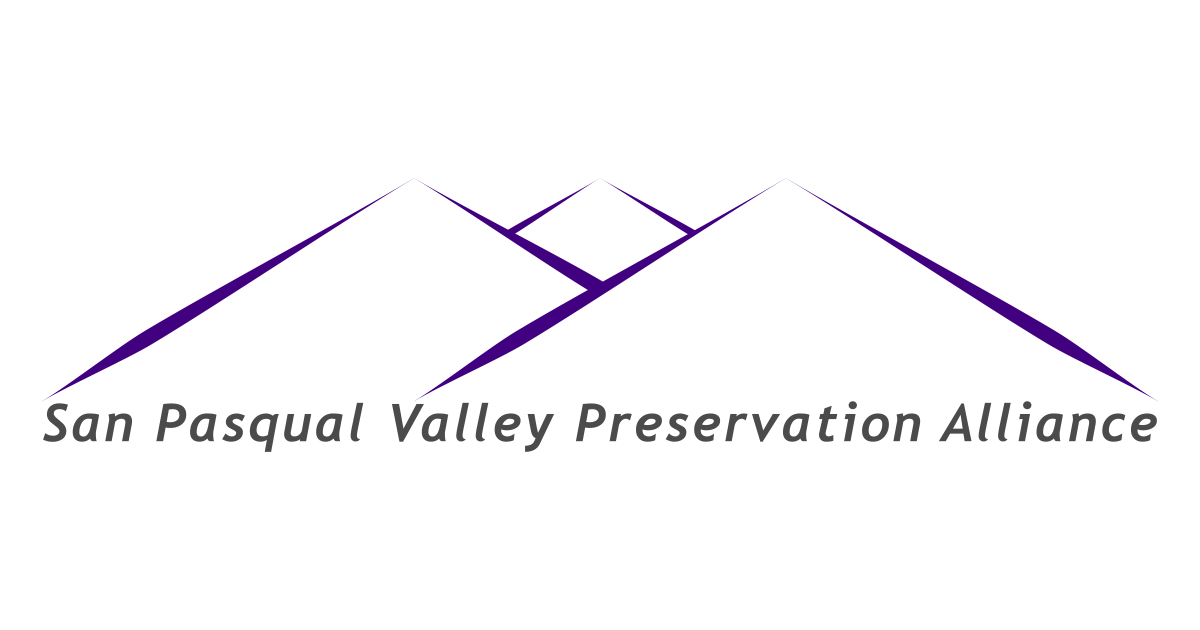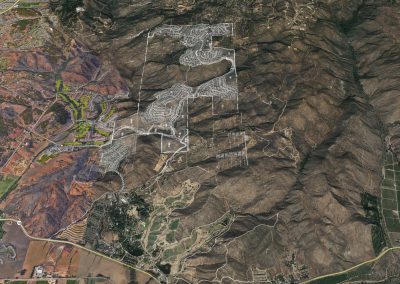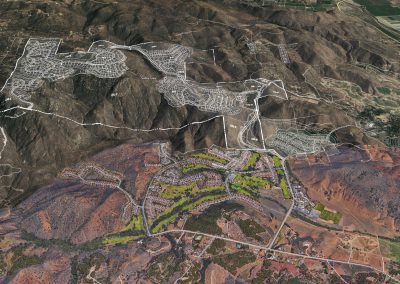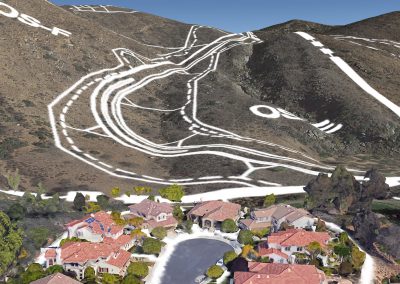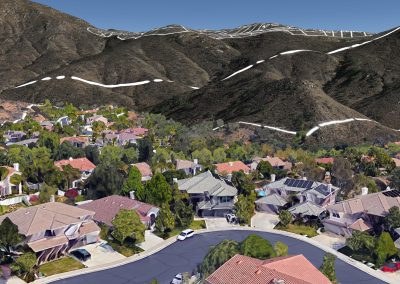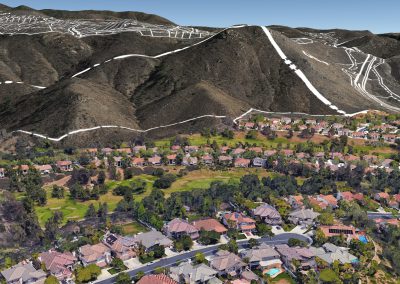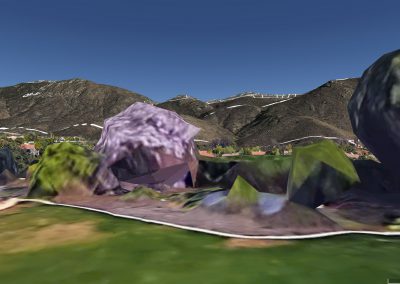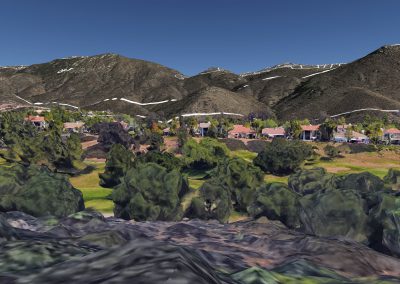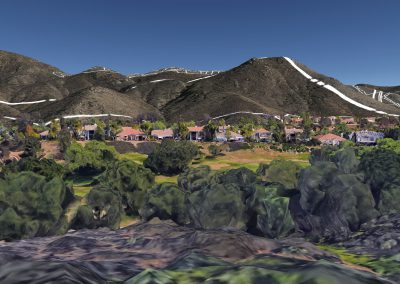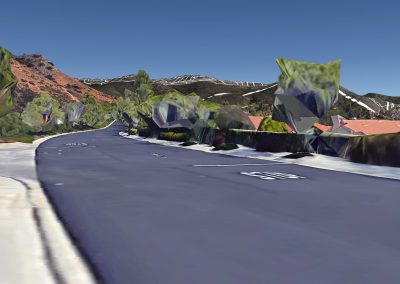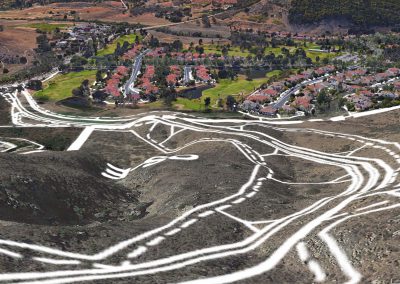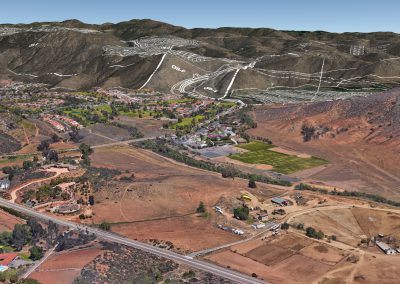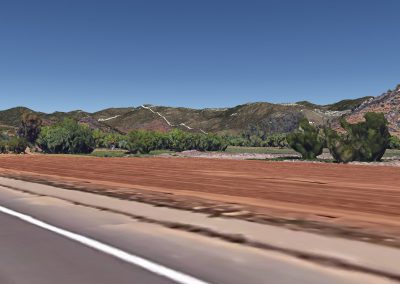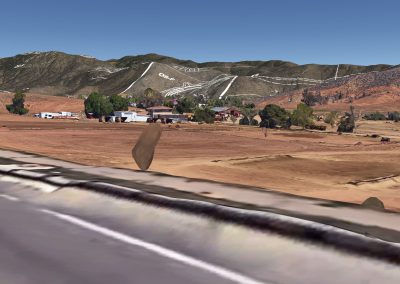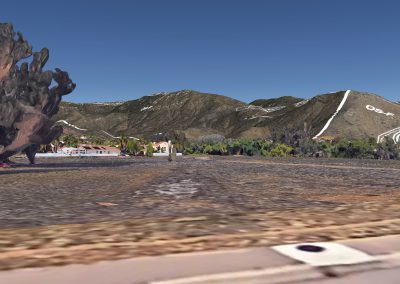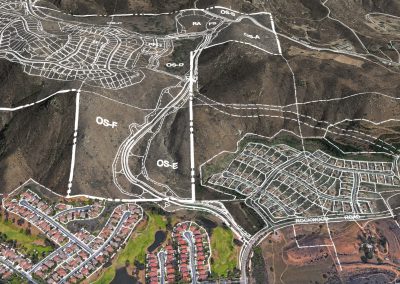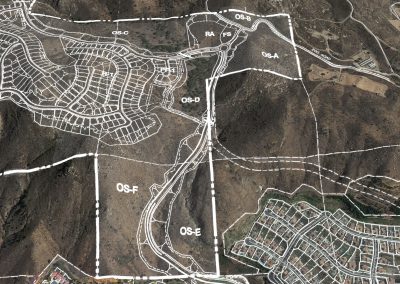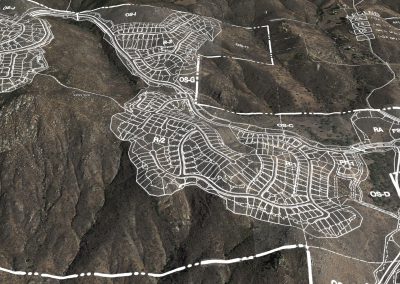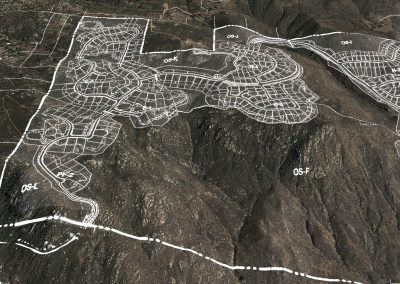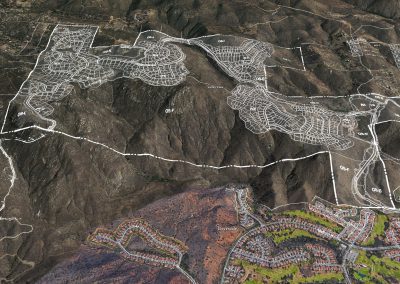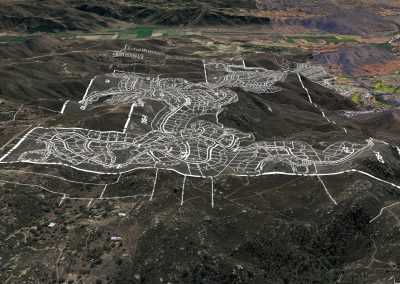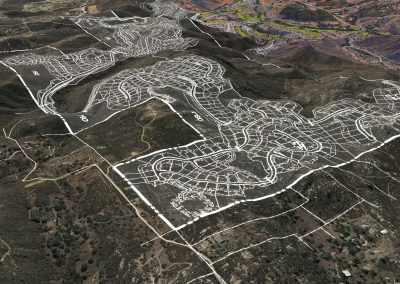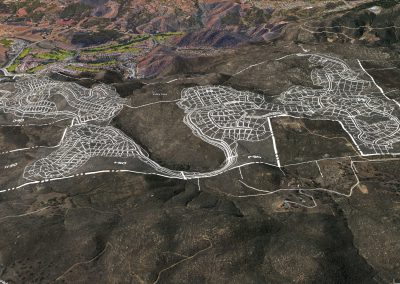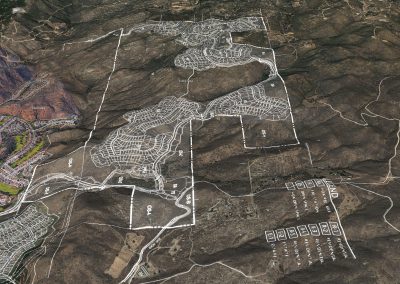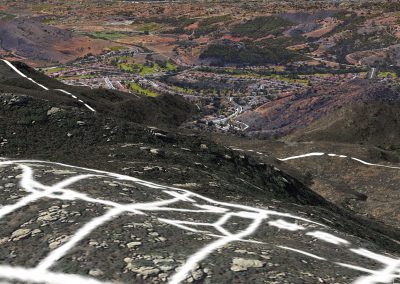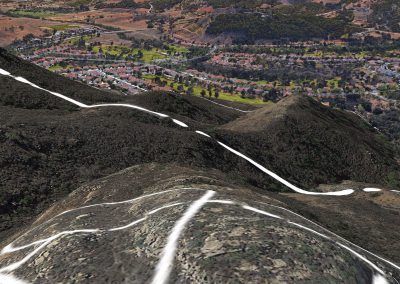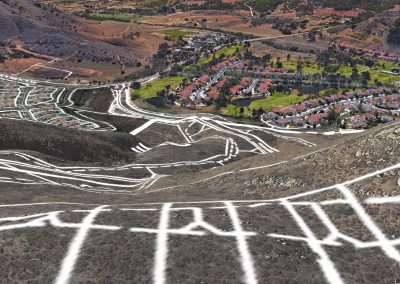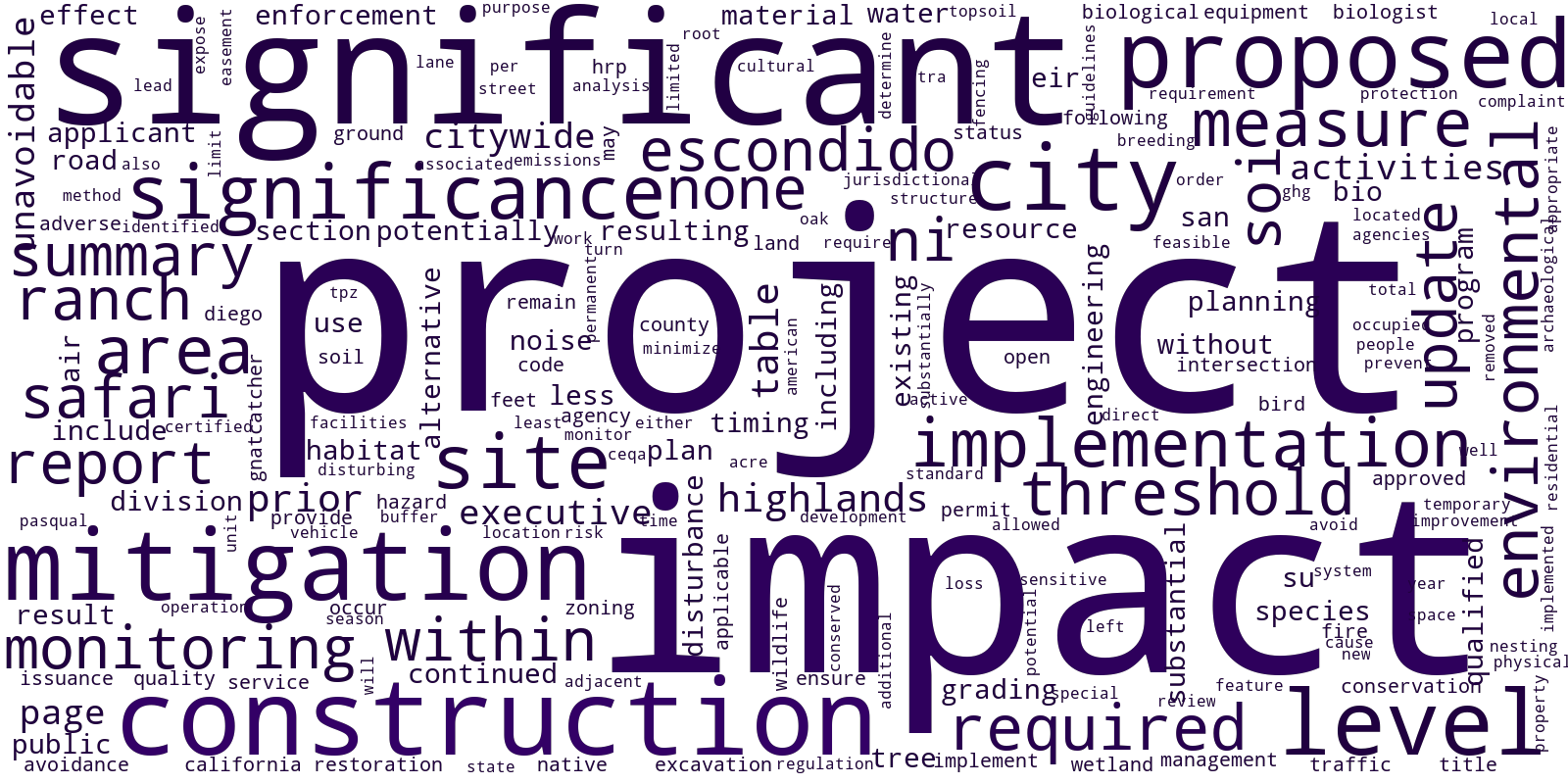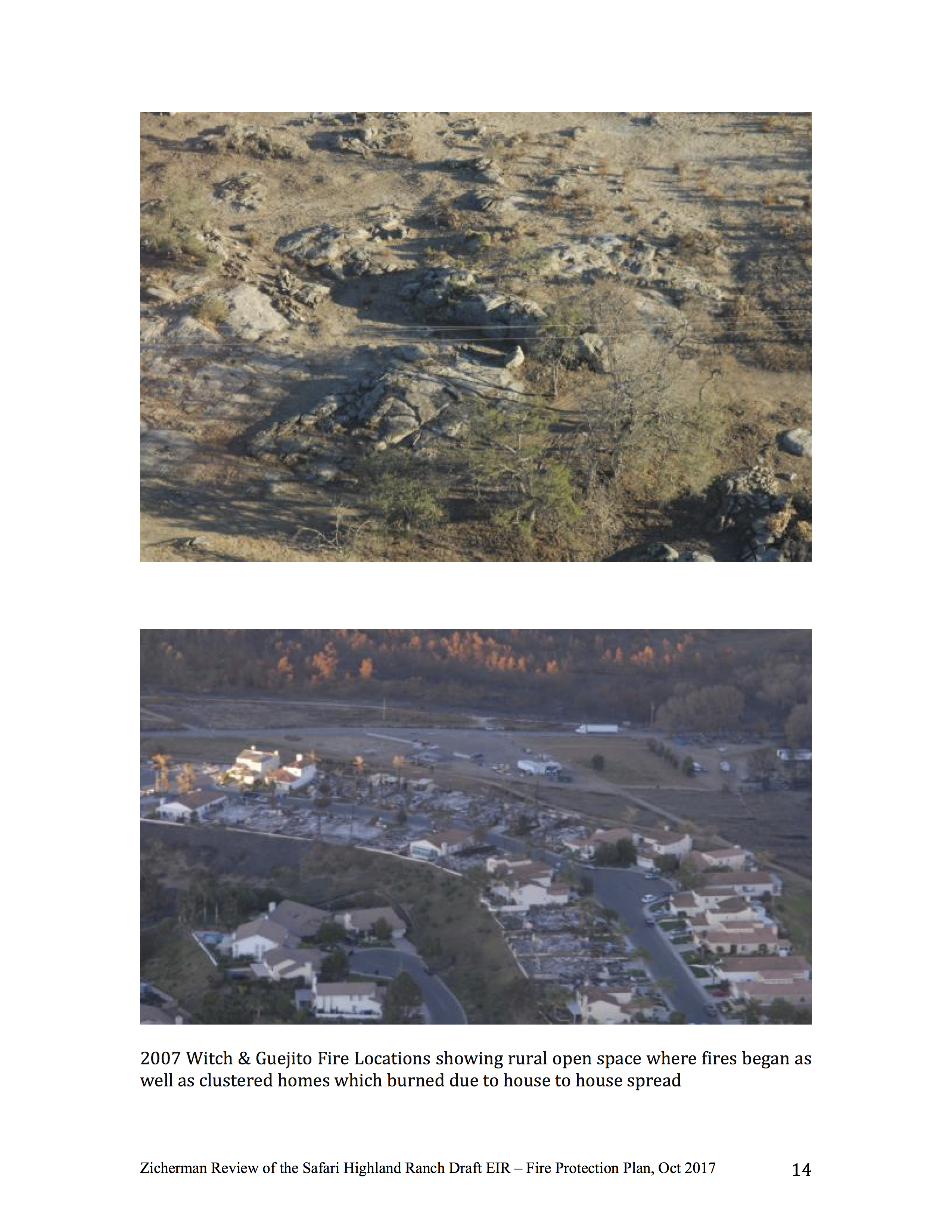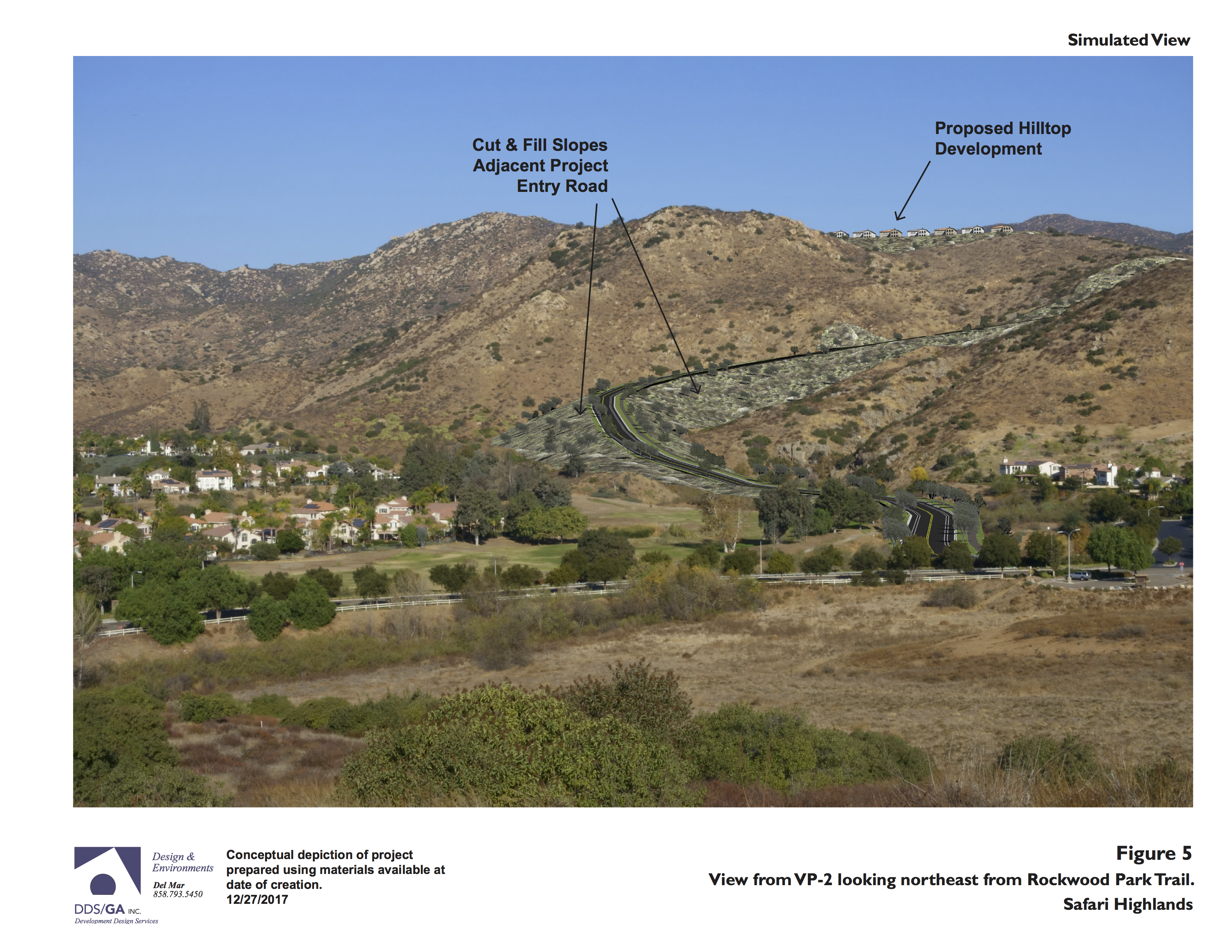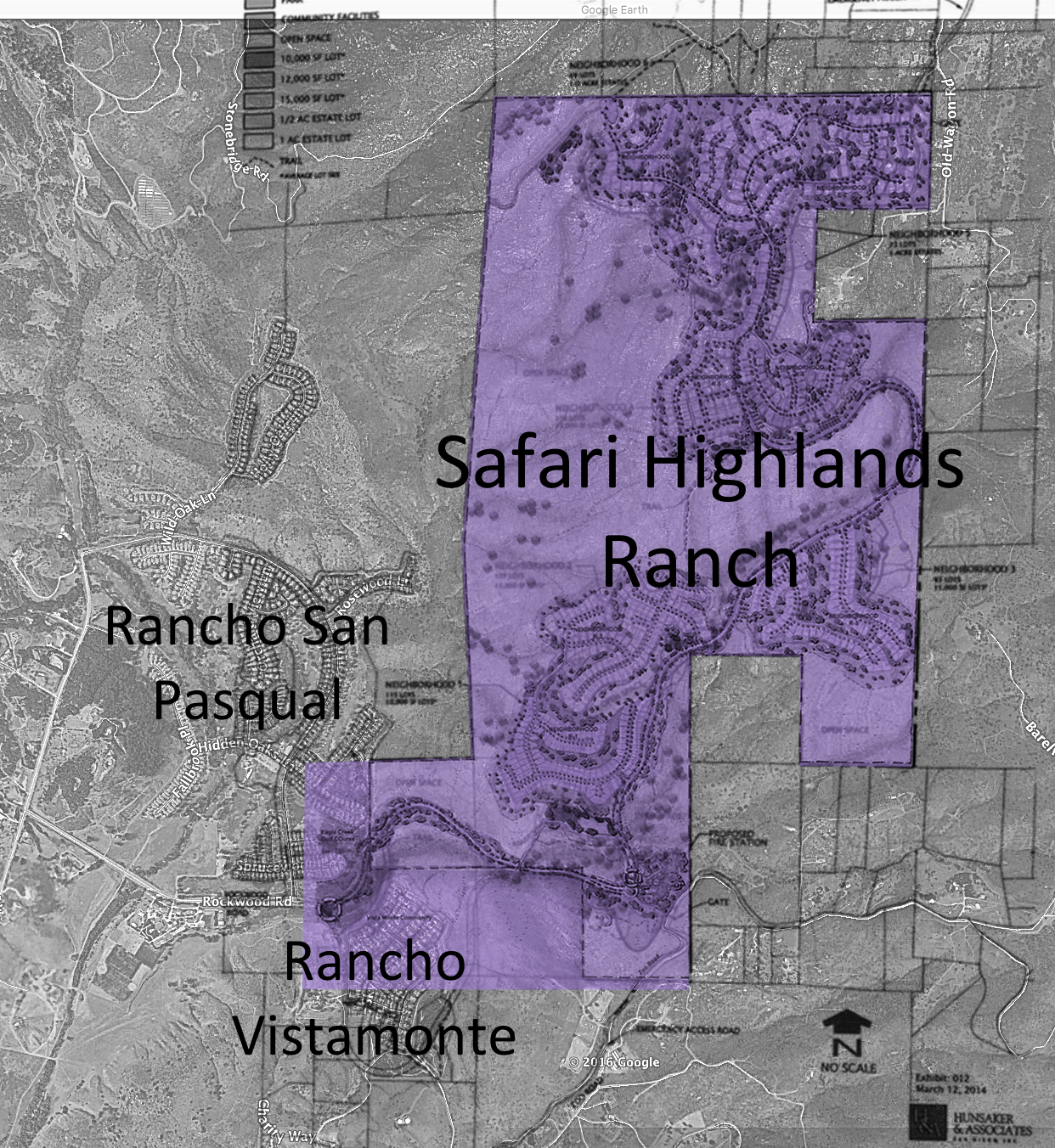Major Announcement!!! Click here to find out more.
The Draft EIR Comment Period Has Closed
The Draft Environmental Impact Report for Safari Highlands Ranch has been released and our team has poured through over 4000 pages laying the groundwork for 2018 and beyond. We will be updating specific information below as well as on our Facebook and Twitter accounts.
Show your support by following us on social media.
SHR Site Gallery
For those who have been asking for more visual details about the proposed project, see the image gallery below for an overlay of the SHR Draft EIR‘s Specific Plan Map on the impacted areas. Please note: these images do not show any clearing, grubbing, cut slopes, fill slopes or other grading artifacts associated with moving more than 4.5 million cubic yards of Earth.
Aerial view above Orchard View Lane looking east towards proposed ridgeline lots – note proposed Safari Highlands Ranch Road
View from Orchard View Lane backyard looking southeast at proposed ridgeline lots – note proposed Safari Highlands Ranch Road
View from top of proposed Safari Highlands Ranch Road looking down on San Pasqual Union Elementary School and South end of Rancho San Pasqual
What the Experts Concluded
SPVPA and the Endangered Habitats League retained an impressive team of experts to analyze the Safari Highlands Ranch Draft Environmental Impact Report:
- Legal Counsel: DeLano & DeLano and Shute, Mihaly & Weinberger, LLP
- Fire Risk and Fire Hazard: Joseph B. Zicherman, Ph.D., SFPE, Berkeley Engineering and Research, Inc.
- Traffic: Neil K. Liddicoat, P.E., Principal, Griffin Cove Transportation Consulting, PLLC
- Hydrology, Water Quality, Geology, Soils and Drainage: Richard R. Horner, Ph.D.
- Noise: Nathan Sibon, Staff Consultant and Chris Papadimos, Principal, Papadimos Group
- Aesthetics and Visual Resources: Adam Gevanthor, Landscape Architect #3393, Principal, Development Design Services & Graphic Access, Inc.
- Fire Evacuation Plan: Thomas J. Cova, Ph.D., Cova Consulting
- Biological Resources: Robert A. Hamilton, President, Hamilton Biological, Inc.
- Slope Impact: Jared M. Ikeda, Land Use Planner, Ikeda Consulting
- Fiscal Analysis: Jun Onaka, Ph.D., Principal, Onaka Planning & Economics
- Air Pollutants, Health Impacts and Greenhouse Gas Emissions: Petra Pless, D.Env., Petra Environmental, Inc.
Below is just a small sample of what they found:
“The proposed Project is a glaring example of the kind of sprawl development that virtually every state and regional planning effort in California today is seeking to contain. Even more troubling, that sprawl would be placed in one of the most environmentally constrained areas of the County. As a result, the Project would have devastating impacts across the board, and, not surprisingly, is inconsistent with every regional planning document applicable to the Project site.” –William J. White, Marlene Dehlinger, Carmen J. Borg, AIC – Shute, Mihaly & Weinberger, LLP (White, et. al., 2017)
“While the single fire station proposed for the project may be adequate to address individual structural fires and non-fire emergency response, it will have no significant impact and be essentially irrelevant in suppressing wild fires entering the project site from neighboring properties driven by downhill Santa Ana winds.” –Joseph B. Zicherman, Ph.D., SFPE – Berkeley Engineering and Research, Inc. (Zicherman, 2017)
“It is fatuous to suggest that disturbing a sizable open space parcel and adding homes and a range of non-native vegetation thru development will in some way be more fire safe than an area left undisturbed.” –Joseph B. Zicherman, Ph.D., SFPE – Berkeley Engineering and Research, Inc. (Zicherman, 2017)
“Dependence on these tortuous and unfamiliar private roads as emergency routes and ensuring their availability to evacuate the project is inconsistent with reasonable minimum safety standards.” –Joseph B. Zicherman, Ph.D., SFPE – Berkeley Engineering and Research, Inc. (Zicherman, 2017)
“Dependence on unfamiliar and irregularly routed roads for evacuations which can take place in darkness and/or with smoke obscuration and reduced visibility are extremely likely to result in injuries and loss of life.” –Joseph B. Zicherman, Ph.D., SFPE – Berkeley Engineering and Research, Inc. (Zicherman, 2017)
“Expecting hundreds of people to evacuate on a limited number of steep routes, some of which are completely unfamiliar to them, is a risky strategy at best where a single two-car collision could lead to blockage of a critical escape route in an emergency.” –Joseph B. Zicherman, Ph.D., SFPE – Berkeley Engineering and Research, Inc. (Zicherman, 2017)
“In addition, it is plausible that the developer could build the first one or two phases of the development and then cease developing the site. In that case there will be no mitigation at all from the proposed fire station. Likewise, fuel modification features aren’t an integral part of the project should it be partially completed.” –Joseph B. Zicherman, Ph.D., SFPE – Berkeley Engineering and Research, Inc. (Zicherman, 2017)
“The DEIR says residents might have to stay in their homes despite the fact that the Project is not being designed to allow for sheltering in place. DEIR at 2.14-16.” –Everett DeLano – DeLano & DeLano (DeLano, 2017)
“The project is inconsistent with the community character of the surrounding neighborhoods, which the DEIR fails to discuss, despite acknowledging that the existing zoning ‘would allow a theoretical buildout of 27 units.’ DEIR at 2.9-2.” –Everett DeLano – DeLano & DeLano (DeLano, 2017)
“The DEIR’s assertion that a [water] shortage in dry years would require conservation from other parties (DEIR at 2.13-30) ignores the fact that the Project exacerbates the need for greater conservation by other parties to meet basic supply needs.” –Everett DeLano – DeLano & DeLano (DeLano, 2017)
“As explained below, the traffic analysis is flawed in several respects and the conclusions in the DEIR regarding traffic impacts are unsupported and contrary to the evidence.” –Neil K. Liddicoat, P.E., Principal – Griffin Cove Transportation Consulting, PLLC (Liddicoat, 2017)
“The DEIR has not adequately justified its declarations of non-significant impacts to the downstream waters that will receive stormwater runoff from Safari Highlands Ranch. My reaching this opinion begins with the inadequacy of analysis of the highly challenging topographic setting and the failure to perform any site-specific soils characterization at all.” –Richard R. Horner, Ph.D. (Horner, 2017)
“In summary, the current project noise assessment is incomplete primarily as it does not fully address regulatory requirements and a proper noise survey of the project site and vicinity has not been conducted to establish with confidence baseline conditions. Furthermore, the study has not proposed mitigation measures for identified significant impacts, rather it classifies them as unavoidable and we disagree with such positions for the reasons noted herein.” –Nathan Sibon, Staff Consultant and Chris Papadimos, Principal – Papadimos Group (Sibon, et. al., 2017)
“The Key Observation Points chosen to evaluate adverse environmental effects that the Project may have to [sic] visual resources are supposed to be representative of areas sharing ‘distinct character and relatively homogeneous visual receptors’ but in most cases, they’re not.” –Adam Gevanthor, Landscape Architect #3393, Principal, Development Design Services & Graphic Access, Inc. (Gevanthor, 2017)
“These otherwise intact natural hillsides and ridgelines will be disturbed and impacted with man-made improvements, verdant irrigated slopes, and hilltop homes backed by sky, in conflict with City policies adopted to protect them. It is anticipated therefore that changes, as a result of project implementation, will be adverse and significant, and will alter public views of the site and/or affect scenic vistas (see Figures 1-7).” –Adam Gevanthor, Landscape Architect #3393, Principal – Development Design Services & Graphic Access, Inc. (Gevanthor, 2017)
“A critical point in this letter is that wildfire ignitions that are less than 10 miles from the SHR site and traveling at average speeds of 2.5 to 4.0 miles per hour would offer less time that [sic] the estimate evacuation times reported in the DUDEK analysis. This could result in scenarios where evacuating residents (vehicles) might be caught in-transit during a wildfire, and as SHR is not a designated shelter-in-place community, this issue needs further study.” – Thomas J. Cova, Ph.D. – Cova Consulting (Cova, 2017)
“The proposed project would result in significant, unmitigated impacts to a variety of native plant and wildlife species, including the federally threatened California Gnatcatcher as well as numerous California Species of Special Concern and other special-status species, each of which requires conservation of an ecologically sound open space preserve system that satisfies all 11 MSCP Findings of Conformance.” –Robert A. Hamilton, President – Hamilton Biological, Inc. (Hamilton, 2017)
“In fact, certification of this EIR would have tremendous potential to effectively undermine all MSCP planning efforts in San Diego County.” –Robert A. Hamilton, President – Hamilton Biological, Inc. (Hamilton, 2017)
“This study has found that over 171 acres or 38.75% of the graded portion of the site is greater than 25% slope and will be impacted by the proposed development. In addition, approximately 69.75 acres or 15.81% of the graded portion of the site is steeper than 35% and will be impacted.” – Jared M. Ikeda, Land Use Planner – Ikeda Consulting (Ikeda, 2017)
“In conclusion, the DEIR fails to adequately address the fiscal impacts associated with the project and fails to evaluate environmental impacts associated with funding shortfalls. With respect to both permanent management of conserved habitat and ongoing operation of a new fire station, the mitigation measures proposed by the DEIR are not sufficient to assure full funding of those activities.” – Jun Onaka, Ph.D., Principal – Onaka Planning & Economics (Onaka, 2017)
“As discussed in the following, the Draft EIR is substantially flawed because it underestimates criteria air pollutant and greenhouse gas emissions during both construction and operation of the Project, fails to identify significant impacts, and fails to require adequate mitigation.” –Petra Pless, D.Env. – Petra Environmental, Inc. (Pless, 2017)
“The Draft EIR does not provide an estimate for how much rock would have to be blasted instead stating that, while the precise amount of blasting required is unknown at this time, it is estimated that about 50 percent of the overall cut slopes would likely require some amount of blasting due to the hardness of on-site materials. 21 The Draft EIR estimates that the SHR project would require 350 acres of grading and involve about 4.6 million cubic yards of cut and fill. 22 Assuming 50 percent of these materials would have to be blasted, about 2.3 million cubic yards of materials would require blasting with explosives.” –Petra Pless, D.Env. – Petra Environmental, Inc. (Pless, 2017)
“The Draft EIR Fails to Analyze Potentially Significant Health Impacts Due to Valley Fever. Valley Fever, or coccidioidomycosis (abbreviated as cocci, also known as desert rheumatism), is an infectious disease caused by inhaling the spores of Coccidioides ssp.,59 a soil-dwelling fungus.” –Petra Pless, D.Env. – Petra Environmental, Inc. (Pless, 2017)
SPVPA and EHL Comment Letters
Below is the list of comment letters drafted by the experts in their entirety. We encourage anyone who is interested to read them.
- White, W. J., Dehlinger, M., and Borg, C. J., AICP. (2017, December 29). Draft Environmental Impact Report for Safari Highlands Ranch and Citywide Sphere Of Influence Update; ENV 15-0009, SUB 15-0019; (SCH #2015091039) [Letter to Mr. John Helmer, Contract Planner, City of Escondido]. San Francisco, CA.
- Zicherman, J. B., Ph.D., SFPE. (2017, December 29). Review of Safari Highlands Ranch EIR of October 2017 (Rep. No. 17-4579). Los Angeles, CA: Berkeley Engineering and Research, Inc.
- DeLano, E. (2017, December 22). Safari Highlands Ranch and Citywide Sphere of Influence Update: ENV 15- 0009; SUB 15-0019 (SCH #2015091039) [Letter to John Helmer, Contract Planner, City of Escondido]. Escondido, CA.
- Liddicoat, N. K., P.E. (2017, December 4). Proposed Safari Highlands Ranch and Citywide SOI Update Draft Environmental Impact Report – Escondido, California [Letter to Mr. Everett DeLano, DeLano & DeLano]. Mackinac Island, MI.
- Horner, R. R., Ph.D. (2017, December 7). [Letter to John Helmer, Contract Planner, City of Escondido]. Seattle, WA.
- Sibon, N., & Papadimos, C. (2017, November 20). Safari Highlands – Escondido California Acoustic Review of Draft Environmental Impact Report (DEIR) [Letter to Everett Delano]. San Francisco, CA.
- Gevanthor, A., Landscape Architect. (2017, December 29). Safari Highlands Ranch DEIR Analysis [Letter to Mr. Everett DeLano, DeLano & DeLano]. Del Mar, CA.
- Cova, T. J., Ph.D. (2017, December 28). Wildland Fire Evacuation Plan for Safari Highlands Ranch [Letter to Endangered Habitats League]. Salt Lake City, UT.
- Hamilton, R. A. (2017, December 8). Review of Biological Resource Issues Draft EIR for the Safari Highlands Ranch Project City of Escondido, San Diego County, California [Letter to Dan Silver, Executive Director, Endangered Habitats League]. Los Angeles, CA.
- Ikeda, J. M. (2017, November 29). GIS analysis of slope in Safari Highlands [Letter to Dan Silver, Endangered Habitats League]. Salinas, CA.
- Onaka, J., Ph.D. (2017, December 11). City of Escondido Safari Highlands Ranch and Citywide SOI Environmental Impact Report (SCH No. 2015091039) – Public Comment [Letter to Mr. Dan Silver, Executive Director, Endangered Habitats League]. La Jolla, CA.
- Pless, P., D.Env. (2017, November 30). Review Draft Environmental Impact Report for Safari Highlands Ranch and Citywide SOI Update, SCH No. 2015091039 [Letter to Carmen Borg]. San Rafael, CA.
Community and Agency Comment Letters
The following is a list of DEIR comment letters submitted by the community and government agencies. We will update the list as more letters become available.
- Hargrave, S., Superintendent, San Pasqual Union School District. (2018, January 2). Draft Environmental Impact Report for the Safari Highlands Ranch Specific Plan and the Citywide Sphere of Influence Update; State Clearinghouse #2015091039 [Letter to John Helmer, Contract Planner, City of Escondido]. Escondido, CA.
- Stewart, G. M., United States Department of the Interior, Fish and Wildlife Service (2017, December 7). Draft Environmental Impact Report for the proposed Safari Highlands Ranch Project and Citywide Sphere of Influence Update, City of Escondido, California (City Case File No. SUB 15-0019; ENV 15-0009. SCH No. 2015091039) [Letter to Johh Helmer, Contract Planner, City of Escondido]. Carlsbad, CA.
- Sevrens, G. K., State of California – Natural Resources Agency, Department of Fish and Wildlife (2017, December 22). Comments on the Draft Environmental Impact Report of the Safari Highlands Ranch Project and Citywide Sphere of Influence Update, City of Escondido, California (City Case File No. SUB 15-0019; ENV 15-0009. SCH No. 2015091039) [Letter to Johh Helmer, Contract Planner, City of Escondido]. San Diego, CA.
SPVPA needs your help!
Click here to be linked to our secure PayPal donations page.
SHR Draft EIR Summary
No spin here. Just the facts. Let’s begin.
There will be a significant amount of blasting and earthwork over the duration of construction.
“Although the precise extent of required blasting is unknown at this time, because of the hardness of on-site materials, a significant amount (estimated 50 percent) of the overall cut slopes would likely require some degree of blasting.” —SHR Draft EIR: Noise, Page 2.10-23
“Site grading would disturb approximately 360 acres and require approximately 4,773,850 cubic yards of earthwork over the duration of construction.” —SHR Draft EIR: Noise, Page 2.10-26
“Rock crushing would also be required to process rock removed with project grading and blasting activities in order to reduce the material for engineered fill.” —SHR Draft EIR: Project Description, Page 1.0-12
There will be significant and unavoidable impacts to air quality, noise and traffic.
“Implementation of the proposed project would result in significant and unavoidable impacts to air quality (construction phase only), noise (operational phase only), and traffic.” —SHR Draft EIR: Executive Summary, Page ES-3
The construction of the fire station and northern emergency access road could be delayed until the project is half completed.
“Upon issuance of the 275th Certificate of Occupancy for the project, the Fire Station, the potable water tank (approximately 743,000 gallons), and grading and surface improvements for the northern emergency access road will have been completed.” —SHR Draft EIR: Project Description, Page 1.0-11
There is no funding for the fire station going forward. Period.
“As of this time, there is no mechanism in place to fund personnel, maintenance, and operational costs. These costs would be subject to further negotiations between the City of Escondido and any other funding source it may identify, such as shared responsibility with other fire districts or municipalities that may also benefit from the fire station’s location.” —SHR Draft EIR: Wildfire Hazards, Page 2.14-17
Furthermore, the fiscal analysis prepared by the developer estimates a surplus of ~$561,000 to the City as a result of sales tax, property tax and other revenue from SHR homeowners.
“As seen in the chart above, the Project is anticipated to generate a $561,820 surplus to the City on an annual basis, once the Project is fully developed.” —Fiscal Impacts of Safari Highlands Ranch (2016), Section 6: FIA Summary and Conclusions, Page 6
HOWEVER, their analysis did not include the cost of ongoing staffing and maintenance.
“While Concordia will pay for the station, the millions of dollars needed to staff it with equipment, firefighters and paramedics over the coming years would be the city’s responsibility.“ —San Diego Union Tribune: Decision nears on Safari Highlands project (10/28/2017)
There are no planned improvements for the school in the Draft EIR.
“However, at the time of EIR preparation, and although the original architect of the school has prepared phased plans for improvement to pick-up/drop-off and parking, no specific improvements have been agreed to, and accordingly such improvements are not proposed as part of the project application.” —SHR Draft EIR: Project Description, Page 1.0-7
Traffic will nearly triple from 3,440 cars/day to 9,649 cars/day on Rockwood Road. —SHR Draft EIR: Traffic and Circulation, Figures 2.12-1 (existing) and 2.12-5 (proposed)
The Rockwood Road improvements consist of a light at the Cloverdale/Rockwood intersection as well as re-striping to make two left turn lanes at that light (that then merge back down to one lane) and perhaps a raised median.
“…the project would install a traffic signal (or alternatively, a roundabout) and restripe the westbound approach to provide one left turn lane and one shared left turn/right turn lane. The south leg of the intersection in the southbound direction would be restriped to provide an additional receiving lane for the traffic turning left from Rockwood Road. The addition of the traffic signal would improve the Rockwood Road/Cloverdale Road intersection to LOS A, which would result in a less than significant impact. In response to community input, and in an effort to retain the existing LOS on Rockwood Road, the project applicant would also construct a raised median or provide a second westbound thru lane along Rockwood Road between Cloverdale Road and San Pasqual Union Elementary. —SHR Draft EIR: Traffic and Circulation, Page 2.12-37
Other “improvements” are off-site and do not include plans to improve the safety or capacity of San Pasqual Road. —SHR Draft EIR: Traffic and Circulation, Pages 2.12-33 through 2.12-35
Looking for more facts? Please read the SHR Draft EIR. Everyone should read it.
Wrong Plan. Wrong Place.
The San Pasqual Valley Preservation Alliance is a tax-exempt 501(c)(3) nonprofit group that has organized to educate, protect and advocate for the ongoing preservation of the San Pasqual Valley, it’s surrounding lands, habitats, resources and wildlife. As a result, we are opposed to the Safari Highlands Ranch development plan, a sprawling 550 home development being proposed for the presently untouched lands on the east edge of the San Pasqual Valley, directly north of the world-famous San Diego Zoo Safari Park. This biologically rich and diverse land is undeveloped and fairly inaccessible open space that is home to a variety of important habitats and wildlife.
This portion of the San Pasqual Valley currently belongs to the County of San Diego and is zoned for, at most, 27 dwellings. A developer, Concordia Homes, seeks to have this land annexed to the City of Escondido; a move that will remove the land from the environmental protections of the County, expand the number of allowed dwellings from 27 to 550, and risks significant and irreparable damage to existing habitat and wildlife.
The Safari Highlands Ranch plan is quintessential urban sprawl by spreading 550 homes in large pockets throughout a huge section of pristine and ecologically valuable land. We seek to ensure that the full impact of this kind of development in the San Pasqual Valley is thoroughly studied and that the short- and long-term effects of a project of this size and scope are accurately represented. We have significant concerns about these kinds of reckless attempts to develop vast areas of biologically rich and important habitat.
- Violates Escondido’s Smart Growth Plan
- Urban Sprawl (up-zoning from 27 to 550 homes!)
- Leapfrog Development (Rancho Guejito)
- Disregards the cultural and historical significance of land once occupied by the San Pasqual Band of Mission Indians
- Overcrowded School (~135-250 additional students added to San Pasqual Union Elementary School)
- Sole Project Access via Rockwood Road
- 200% Increase in Traffic
- Bottleneck Evacuation – No Additional Southern Escape Route
- Construction = Blasting + Dust + Poor Air Quality + Potential Health Issues + More Road Damage (Potholes) for Years
- Reduced Quality of Life + Increased Inventory = Depressed Home Prices
Visit the Safari Highlands Ranch Specific Plan on the City of Escondido’s SHR Website for the latest planning updates.
Without a second primary access road (i.e. entrance/egress, open at all times) planned for Safari Highlands Ranch, there are concerns about traffic congestion as well as vehicular and pedestrian safety on Rockwood Road. Also, because there are no additional southern evacuation routes planned, there are serious concerns about increasing emergency evacuation times resulting from the expected increase in people and cars in the area. Furthermore, with public trails and a “Village Core” plan that includes a corner store and an outdoor amphitheater, Safari Highlands Ranch is actually designed to attract additional traffic from outside the area. This plan not only ignores issues related to a dramatic increase in traffic associated with 550 homes, it actually makes those problems worse by drawing outside traffic, not otherwise tied to Safari Highlands Ranch, down the same roadway that will experience a ~200% increase in traffic just from the 550 houses. With major employment and activity hubs located many miles away and a lack of robust public transportation options servicing the area, the environmental impact of increased development even further outside the urban core of Escondido is a significant concern long-term.
We join with many concerned residents of the San Pasqual Valley, along with state and local Groups in opposing efforts to further develop this region. We will be adding additional information on specific areas of negative impact and public concern as we proceed. Check the Latest News page for the most up-to-date information on the SHR proposal process. You can also find all of the information submitted to the City of Escondido by Concordia at: https://www.escondido.org/safari-highlands-ranch-specific-plan.aspx
As a matter of significant public interest, we encourage everyone to stay informed, ask questions, share concerns and continue to actively participate in the public process. We welcome anyone who feels strongly about the need to preserve this important area of open space and are opposed to this kind of development in the San Pasqual Valley. If you would like to get connected with the San Pasqual Valley Preservation Alliance, and get updates and information on this project, visit our Contact page to be added to our list of supporters.
We depend on donations to support our wide-ranging and ongoing efforts to preserve and protect the San Pasqual Valley. As a tax-exempt 501(c)(3) nonprofit, donations are tax-deductible.
Show your support by following us on social media.
SPVPA needs your help!
Click here to be linked to our secure PayPal donations page.
